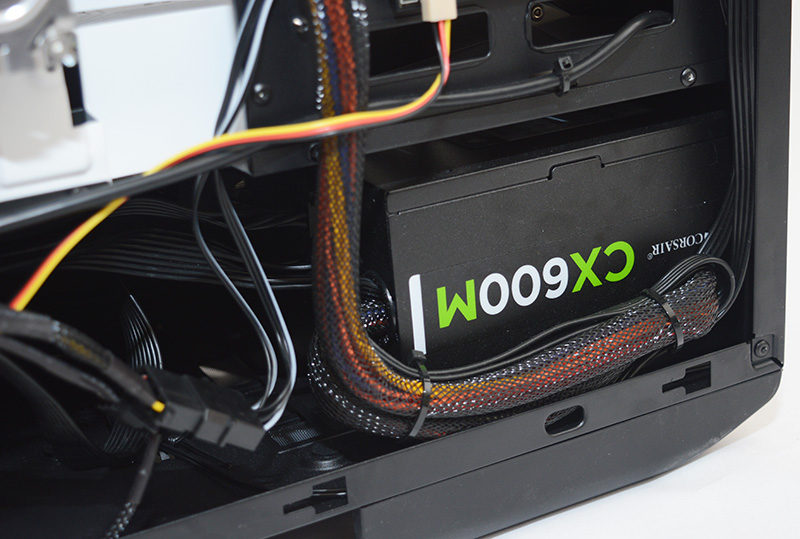Cyberpower Hyper Liquid 100 GTX 1080 Gaming PC Review
John Williamson / 8 years ago
A Closer Look
Despite only conforming to the ITX standard, the NZXT Manta is surprisingly large and has enough room to accommodate a full water cooling setup without restricting the layout options too much. On another note, the chassis’ unusual curvature is rather striking and unlike anything I’ve encountered before. During CES this year, I discussed the case with NZXT and they explained how difficult it was to consistently mould a contoured curved shape using steel side panels. Honestly, the pictures struggle to provide an insight into the level of engineering involved and aesthetic appeal the Manta has. Also, the chassis’ side-panels are extremely sturdy and exhibit the highest build quality imaginable. Another great feature is the power supply cover which obscures any trailing cables and allows for a much neater finish.
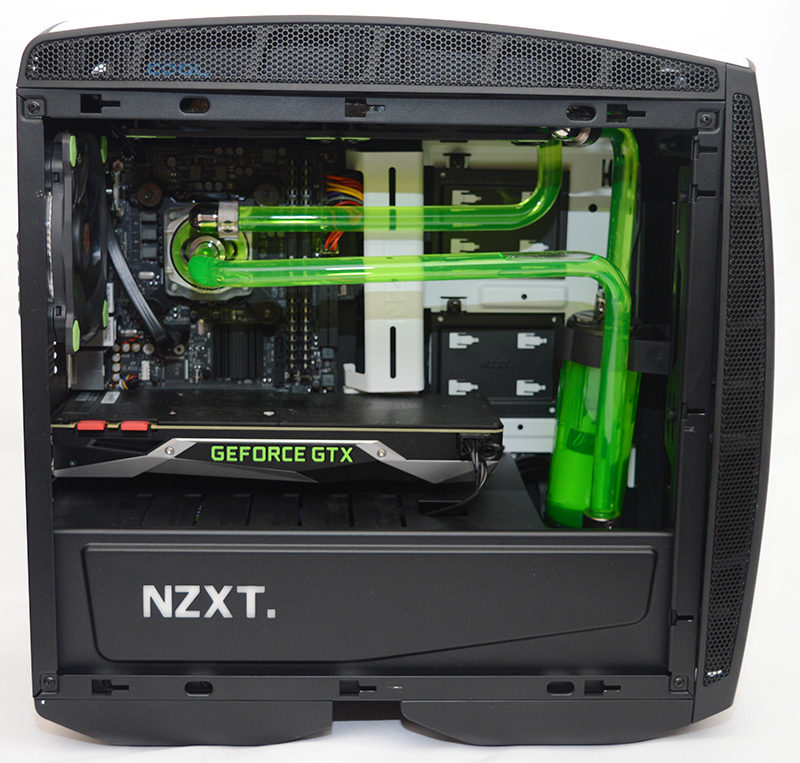
Here we can see the chassis employs a black and white colour scheme which provides a wonderful contrast and helps the system to be distinctive. Also, the Cyberpower logo features a sharp, bold design and compliments the chassis’ styling in a seamless manner. This combination is perfect and it seems like the Cyberpower branding was made specifically for the NZXT Manta. Of course, the white finish is prone to accumulating dust and can mark easily if the end-user has dirt on their hands. On a more positive note, the matte coating resists fingerprints and the paint application is performed to a high standard.
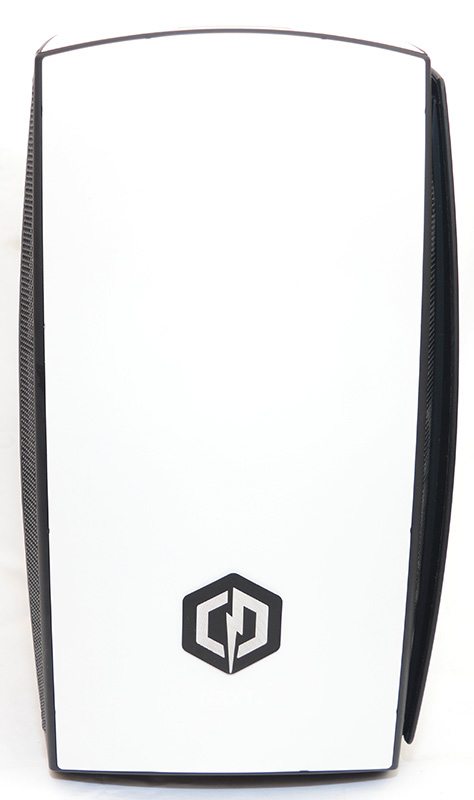
Cyberpower decided to use Monsoon hardline 1/2 x 5/8 acrylic clear tubing manufactured from premium PMMA which allows for attractive tubing runs and is renowned for having exceptional reliability. Additionally, the clear tubing is useful to proudly display the EK UV green pre-mixed coolant which looks remarkably similar to radioactive material. Please note, if you’re not too fond of the green hue, it’s possible to choose from a wide range of colours. To create a better synergy throughout the build, Cyberpower included Thermaltake Riing 12 fans which utilise green anti-vibration mounts and incorporate LED lighting. This works alongside the coolant and GeForce GTX logo to ensure the rig has a sense of colour coordination. The fans’ bright illumination leads to a more spectacular appearance and accentuates the coolant’s colour. As you can see, the graphics card is installed with a tight cable run and the backplate should protect the PCB in the unlikely event of a leak.
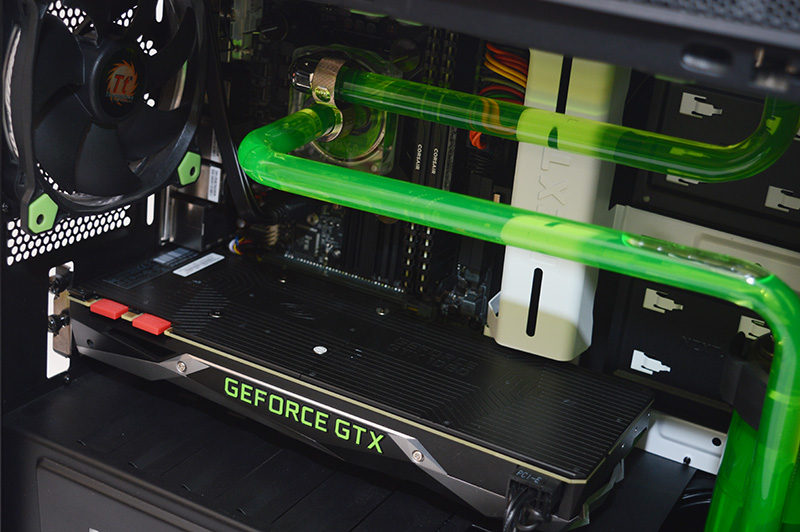
The Alphacool Cape Corp Coolplex Pro 15 LT reservoir is made from durable Plexiglass and supports standard G1/4″ threads. Additionally, the end-user is able to install lighting modules and adjust the loop via the embedded fill port. As you can see, an EK thread has been used to connect the tubing which has a fairly direct route to the CPU block. Next to the reservoir is the Phobya 12V DC12-260 pump which offers an excellent flow rate at respectable noise levels. While the final tubing position is good, I’d prefer to see the lines slightly straighter. Saying that, the reservoir and pump combo in the front is the best solution given the chassis’ restricted space.
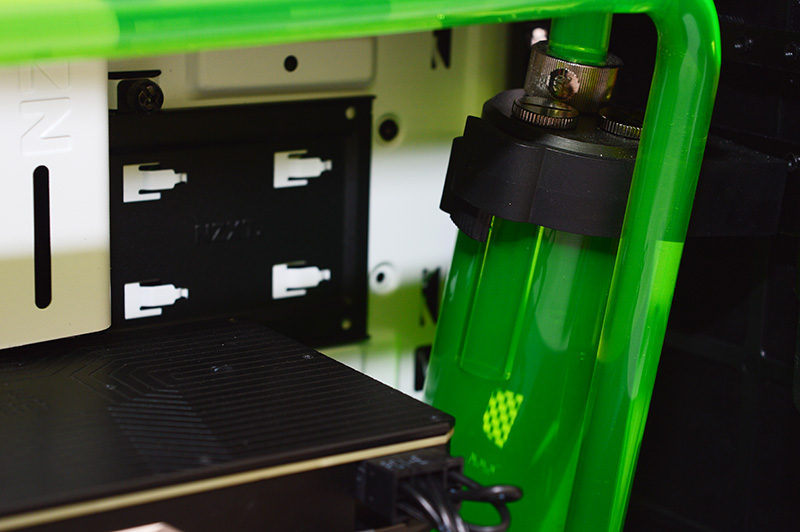
Next up is the Phobya UC-2 block which features a transparent finish and allows you observe the water flow. Additionally, the highly-revered block opts for industrial style M4 mounting hardware and has a copper slot structure cooling plate to maximise heat dissipation. Also, the water block includes a middle layer, based on a patented microchannel recirculation technology which enhances the performance considerably. From this image, we can see the wiring is quite neat although the trailing USB 3.0 cable is easily visible even when the side panel is closed. To be fair, it’s probably the only way the cable could be routed and you adjust to the positioning really quickly.
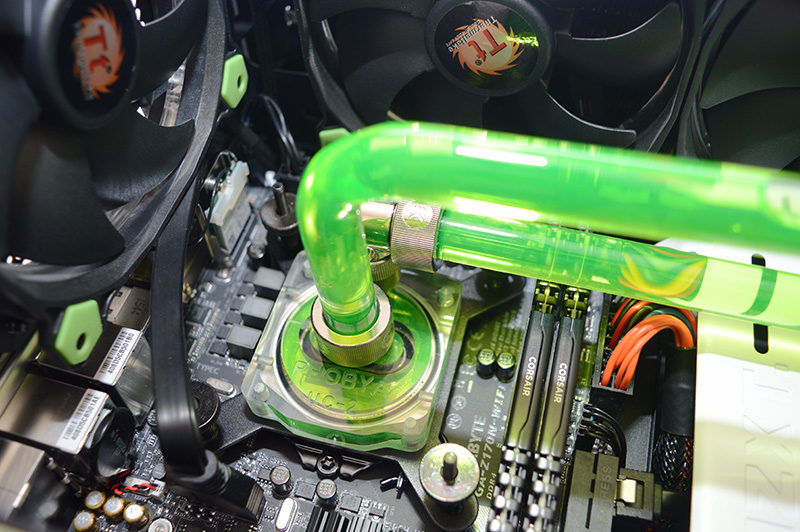
The system is equipped with an Alphacool NexXxoS ST30 240mm radiator which has a total thickness of 30mm. This allows the radiator to contribute towards great thermal efficiency without overhanging too close to the CPU block in a tight space. Additionally, every attribute of the radiator is manufactured from copper and is a significant improvement compared to the aluminium radiators commonly seen in Asetek or CoolIT’s closed-loop solutions.
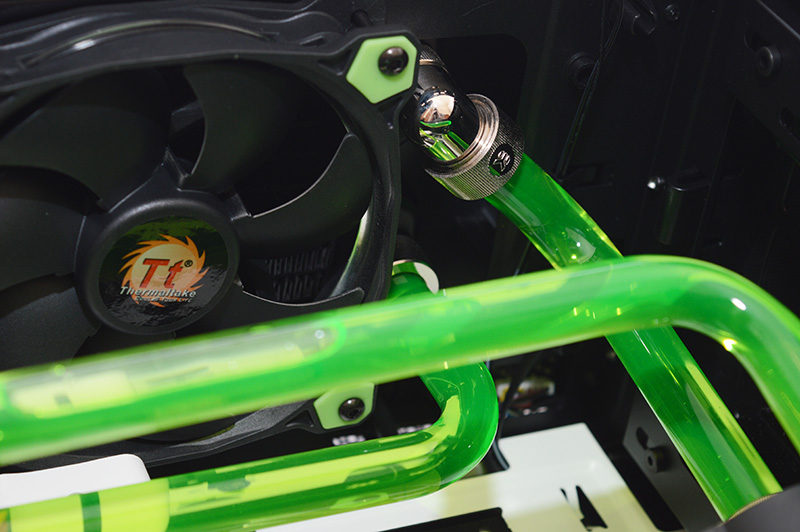
Once powered on, the chassis’ NZXT logo lights up alongside the fan’s green ring and GeForce logo. This infusion of colours is pretty impressive and a joy to look at.
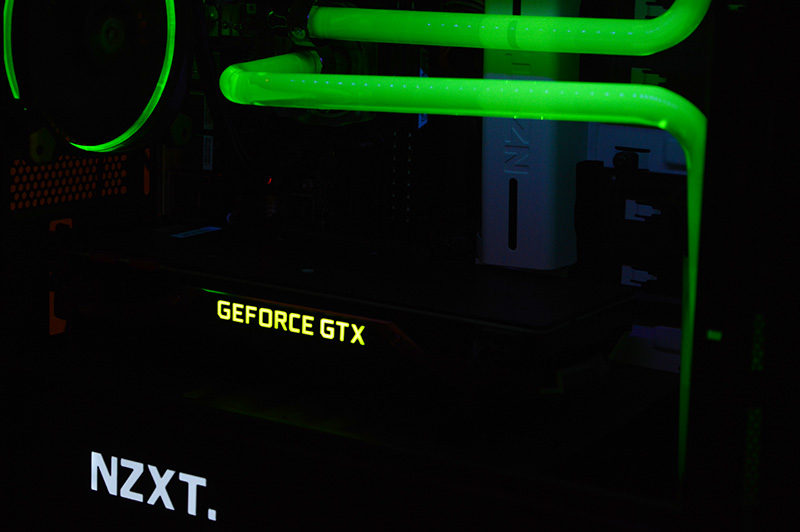
In terms of cable management, Cyberpower has done a commendable job and taken full advantage of the chassis’ cabling cover. This cover, positioned in the centre, is designed to hide the full cable length and keep the visible cabling to a minimum. While it works extremely well, I’m an advocate of rubber grommets and believe they provide better versatility. Additionally, the chassis’ lack of integrated velcro straps is disappointing and makes the cabling process more frustrating. When you take these minor flaws into account, Cyberpower has excelled and responded to the situation really well.
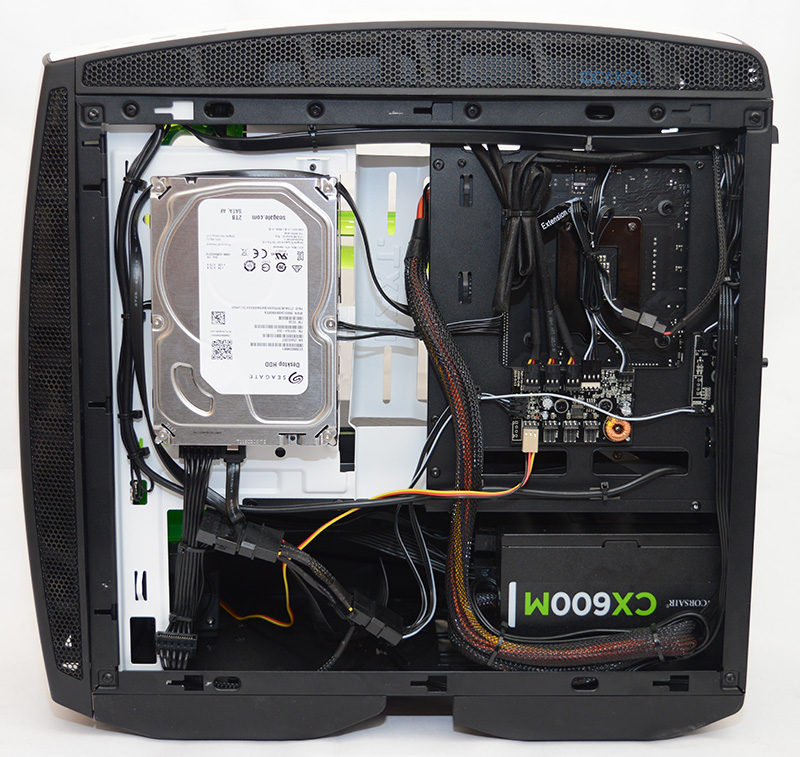
To maintain a clean, sophisticated finish in the front section, Cyberpower utilised the chassis’ PWM hub. The hub allows you to connect a huge range of fans and control them using software. This module is much better than Phanteks’ fan hub seen on models like the Enthoo Evolv ATX for a number of reasons. Firstly, there are more headers to attach fans without relying on Y-Splitters and the PCB has a more substantial mount which doesn’t wobble. In this build, the radiator fan cabling, and rear fan connect via extension cables which are neatly tied together. Rather bizarrely, the chassis has a LED switch which I can only imagine is deployed to light up the rear I/O. I have to admit, this is actually useful and makes it easy to plug in USB drives or other devices late at night.
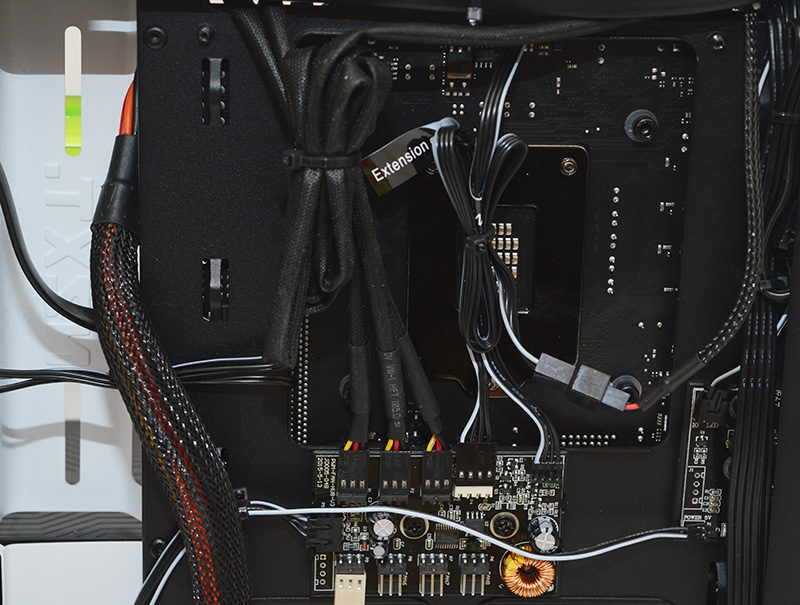
The NZXT Manta is designed with SSD or M.2 storage in mind and doesn’t have a lot of options for 3.5-inch mechanical disk drives. Saying that, it’s possible to install a 3.5-inch drive without any problems even though the end-result is unsightly. To be honest, the hard drive mount looks out of place and like someone has modded the case to add a 3.5-inch drive. Saying that, you’re not going to notice this once the side panel is shut and Cyberpower routed the surrounding cables in a professional way.
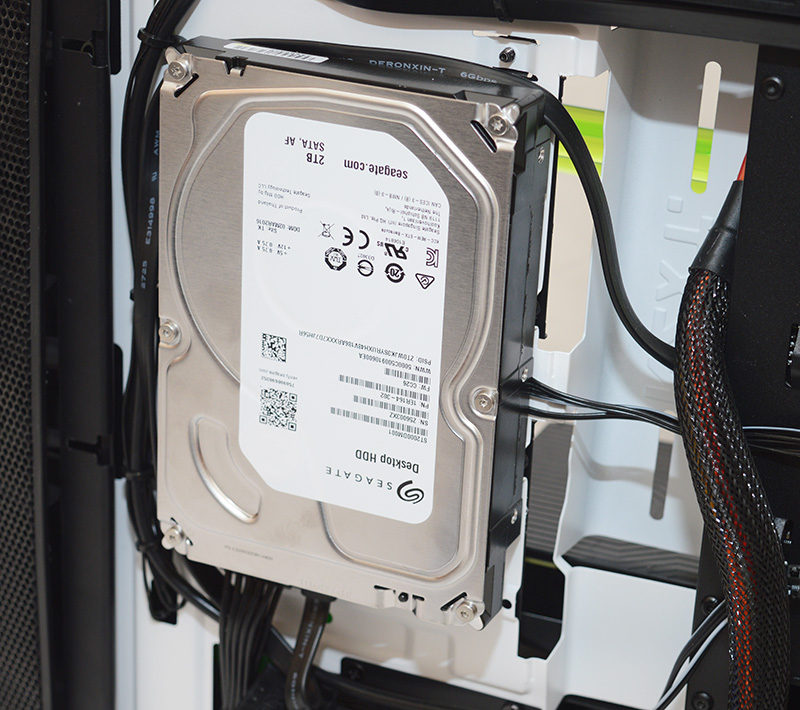
Towards the power supply, it’s evidently clear that the 24-pin connector, 8-pin EPS and SATA power cables have been positioned using a straight, logical cabling run. Thankfully, Cyberpower used a copious supply of zip-ties and ensured the fitting wasn’t too tight. As a result, the zip-ties shouldn’t sudden break over time and the cabling is strong enough to withstand the system being moved on a regular basis.
